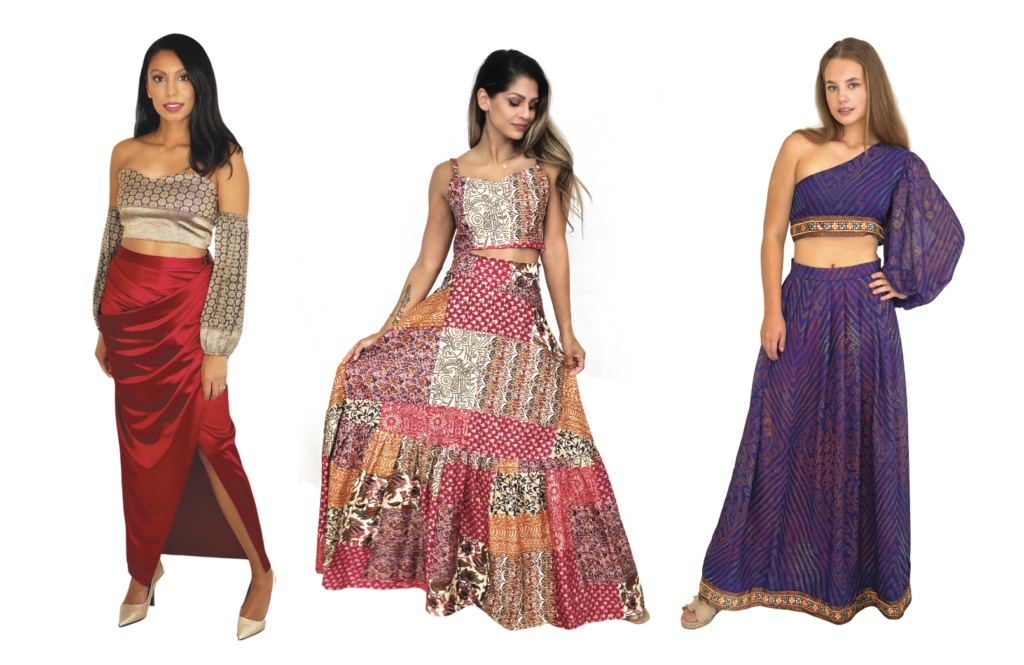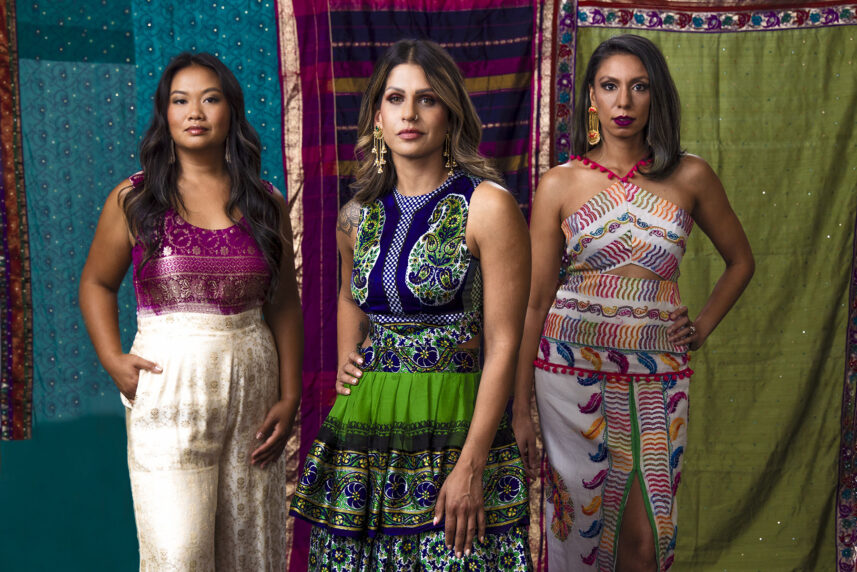Article:

SARIS REBORN
BY USHA SANKAR
ABOVE: Sheetal Patel (left) is wearing the ‘Sarina’ —a midi dress with a cutout at the waist. It was made from a multicolor embroidered dupatta, a traditional Indian garment similar to a shawl. Julkee Fashion’s owner and designer, Julie Patel (center), is wearing a ruffle dress made from her mother’s sari, which was also the first sari Patel ever wore as a teenager. This is the type of outfit Julkee Fashions designs from heirlooms people wish to preserve in consultation with clients. Anousone Turner (right) is wearingJulkee’s best-selling wide-leg jumpsuit, the ‘Amina,’ made from a cream and dark magenta silk sari.
—
Walking into Raleigh-based designer Julie Patel’s third-floor home feels like entering a world of limitless possibilities. Visitors are greeted by intricately woven borders, heavily sequined pieces, peacock embroidery cutouts, mirror work designs, and colorful swathes of chiffons, georgettes and silks, all waiting to be converted into alluring dresses, gowns, jumpsuits, skirts, crop tops and more.
Patel’s fashion brand, Julkee Fashion, is all about converting six meters of cloth—the standard length of an Indian sari—into outfits that are both sassy and practical. Sari draping can be a complex affair. The garment is tucked into an underskirt and wrapped around, with pleating in the middle and a shoulder overhang. Patel recalls how cumbersome the sari felt when she had her first child. Both nursing the baby and running after her as a toddler were painful and frustrating in a sari.
That is when Patel hit upon the idea of making something more practical, and produced the first of her flared skirts with a bodice from sari fabric. The Julkee label was born.
“I realized I could wear it not only to weddings, but to lunches, too,” Patel says.
Patel grew up in Charlotte and moved to Raleigh when she entered North Carolina State University to study business and marketing. There, she met her husband and soon settled into married life.
“I was working corporate here and there. We were in the hospitality sector,” she recalls.
So how did Patel get into sewing? Like many other young Indian women just starting out in marriage, Patel was given a sewing machine by her mom—so that, in her mother’s words, “you can take care of minor alterations.” Patel soon began experimenting and making her own clothes. YoutTube tutorials proved handy, as did books that taught the basics. It also helped that she wasn’t afraid of trial and error. “I reckoned I didn’t need to pay for classes when I had the internet,” Patel says.

She soon taught herself how to make jumpsuits and trousers. “I would just get ahold of a pattern and adopt it,” she says. Patel’s hobby morphed into a business two years ago, when she began receiving requests from friends to convert saris tucked away in dark corners of closets after being worn just once to clothing they could wear more often. “A sari is much like a prom dress,” Patel explains.
She now has a small business unit in India, comprised of three seamstresses and a coordinator, which handles most of the sewing. “I do the designing now, and ship the fabrics and my designs. So I now have more inventory,” Patel says, adding that for a long time, keeping up with the inventory was a major challenge.
Almost all of the fabric that Patel works on has come from donated saris from her friends and family. The sari donations come in a variety of fabrics, from lightweight ones to heavy woven silks. In addition, most saris have a border and a shoulder overhang called the pallu. These parts tend to be heavier than the rest of the sari, and Patel says she pays close attention to matching the weight of the fabric with the designs she has in mind.

“I might use the pallu for a simple pencil dress, or the stiffer silks for blazers,” she says. Her favorite fabrics, though, are the lighter ones, because they work well with flowy designs. The many backless, ruffle dresses in her inventory speak to this preference.
How does she come up with her designs? “My best ideas come to me when I’m lying in bed,” Patel says, smiling. “Or when I see other designs and think how I can make my own version of that.”
Julkee Fashion now has customers from all across the U.S., and also some international customers (specifically from the UK, Canada and Australia). Most customers are of Indian origin, she concedes, although she has customers outside of this demographic who are typically looking for an outfit to wear to an Indian event.
“Non-desis worry about whether wearing [one of] my outfits is cultural appropriation,” Patel explains. “‘I’m not Indian, or even Asian. Does it look bad?’ they wonder. My response always is that as long as you know where it came from or you know the significance and are appreciative of its beauty, it doesn’t bother me.” (“Desi” is a term that refers to someone of South Asian origin.)

To help reach a wider audience, Patel has increased her advertising, and is marketing through Instagram and doing professional photo shoots.
“Most of my sales come from Instagram, and my customers are mostly in the 25–45 age group,” she says.
While her younger clientele come looking for something different, the older folk typically feel they are done with their saris and wonder what they can do with them. “My mission is to take old stuff and make it new,” Patel says. Brides are usually looking for pre-wedding event outfits, and here the jumpsuits, shorter dresses, or cropped pant and top outfits are the hot favorites. The drape top—an innovative creation that looks like a sari drape from the front but is actually a pant and top—is not far behind.
Looking to the future, Patel says her goal is to triple her sales in the next year. She is also hoping to attract celebrity clientele. She proudly shares that singer Vidya Vox once reached out to her to convert her mom’s sari into a pant and cropped top with cold shoulder ensemble.
Patel is also looking to diversify her product line with table runners and cushion covers that have been upcycled from saris. Some of her particularly innovative pieces are thorans (traditional door decorations) and Diwali wreaths created out of sari borders.
“But I do have to focus,” chuckles Patel, who struggles to rein in her creativity when it threatens to run amok.
While she does accommodate requests to work with designs that people bring to her, she prefers working on her own. For designs she is familiar with, she can come up with an outfit within six hours. “I personally like to make things that are trendy, but I recognize that I need to also have pieces that cater to more people. They should be wearable in most situations for most people.”
Patel calls her custom pieces “Saris Reborn,” and she is certainly all set to breathe new life into these iconic garments and adapt them to modern times.
Check out Midtown Magazine for more feature stories from around the Triangle.



